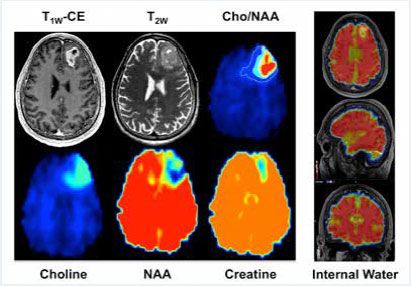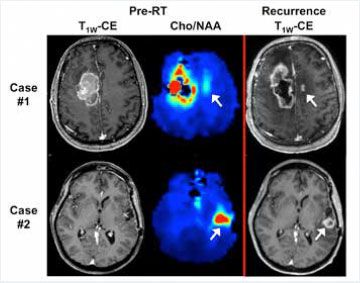Publication
Article
Oncology Live®
Advanced 3D MRI Technology Marks a Leap Forward in Glioblastoma Imaging
Author(s):
Although advances have been made in imaging techniques for patients with glioblastoma multiforme, new tools are needed to supplement standard imaging sequences.
Hui-Kuo Shu, MD, PhD
Associate Professor
Although advances have been made in imaging techniques for patients with glioblastoma multiforme (GBM), new tools are needed to supplement standard imaging sequences. Researchers at the Winship Cancer Institute of Emory University are helping to develop the next generation of imaging strategies for this highly aggressive malignancy.
GBM, the most common primary malignant brain tumor in adults, remains relatively resistant to therapy. Standard treatment for GBM, including resection followed by radiation therapy (RT) and concurrent/adjuvant temozolomide (TMZ) chemotherapy, results in 15 months’ median survival and <10% 5-year survival.1,2
These tumors are locally aggressive, displaying significant brain parenchymal infiltration. Conventional imaging for these tumors consists of magnetic resonance imaging (MRI) with and without contrast, which allows visualization of the enhancing tumor on a T1-weighted contrast-enhanced (T1W-CE) sequence and of surrounding regions of edema that contain infiltrating tumor on T2-weighted (T2W) or FLAIR sequences.
Spectroscopy for Brain Imaging
However, these standard techniques may be insufficient to fully evaluate GBMs. Enhanced regions on T1W-CE images represent areas with leaky vasculature where contrast extravasates and is not necessarily tumor specific. Increased signaling on T2W or FLAIR images, which shows increased water signal, may or may not represent regions with nonenhancing tumor infiltration.Magnetic resonance spectroscopic imaging (MRSI), a specialized technique performed on clinical MRI scanners that does not require intravenous contrast, offers additional information. It determines relative concentrations of certain metabolites in interrogated regions of the brain.
With MRSI, detection of certain metabolites such as choline (Cho) have been associated with GBMs, while the presence of others such as N-acetylaspartate (NAA) have been associated with normal brain tissue This technology, because it is based on metabolite content, may distinguish a malignant tumor from a more benign process that could not be differentiated by conventional MRIs.
3D Whole Brain Spectroscopic MRI
Current commercially available packages for performing MRSI involve either single voxel techniques that assess a relatively large region (eg, 8 cm3) or 2D multivoxel techniques that assess along a plane (eg, 2 cm thick) at individual 2 cm3 (1 x 1 x 2 cm) regions. These implementations require relatively long scan times (2-5 min/voxel with single voxel techniques and 6-8 min/slab with multivoxel techniques), have poor signal-to-noise ratios and resolutions, and are unable to assess the entire brain within a clinically acceptable time frame.At Winship, we are developing the clinical utility of a more advanced MRSI technique that permits quantitative assessment of metabolite content throughout the brain at significantly higher resolutions (~0.1 cm3) while maintaining reasonable scan times (~14-15 minutes).
Working with Andrew Maudsley, PhD, and his group at the University of Miami, the original developer of the spectroscopic imaging sequence we are using,3,4 we have implemented this advanced sequence, now termed spectroscopic MRI (sMRI), on our Siemens Tim Trio and Prisma 3T MRI scanners to acquire whole brain metabolite maps.
The output is further assessed/visualized on Velocity AI from Varian Medical Systems in Palo Alto, California, a software originally developed at Emory to evaluate patient imaging charts with easy tools for image set registration.
Clinical Application of Advanced sMRI
A GBM case is imaged with standard MRI with or without contrast and advanced volumetric sMRI, and fused in Velocity with registered images (Figure 1). While enhancing tumor with surrounding edema is clearly present, metabolite and metabolite ratio maps suggest tumor infiltration beyond what is seen on conventional image sets.The Quantitative Imaging Network (QIN) was established by the National Cancer Institute (NCI) in 2009 to develop novel quantitative imaging methods and deploy these tools for cancer clinical trials.5 Our research group at Emory, led by Hyunsuk Shim, PhD, received funding as a QIN site in 2013 and has been charged with the development of 3D volumetric sMRI for GBM imaging. Currently, we are conducting a clinical trial exploring the use of sMRI to assess response to belinostat, a histone deacetylase inhibitor (HDACi), combined with standard therapy for newly diagnosed GBM. This drug is FDA approved for recurrent T-cell lymphomas but has not been tested against GBM.
Figure 1. Standard Versus Spectroscopic MRI Images in Diagnostics

Standard magnetic resonance imaging (MRI) and spectroscopic MRI (sMRI) metabolite maps of frontal GBM case are compared at left. With sMRI, choline (Cho) elevation and N-acetylaspartate (NAA) depression is evident at and beyond where tumor is defined on standard MRI T1w-CE and T2w scans. The contour on the Cho/NAA ratio sMRI map represents 1.5x normal values defined on the contralateral brain. At right, the internal water map demonstrates the whole brain coverage achieved on the sMRI scan.
A significant percentage of GBMs display global epigenetic changes6 that may indicate sensitivity to this drug class. Belinostat crosses the blood-brain barrier (BBB)7 and initial assessment of this drug in a rat GBM model revealed significant activity against intracranial tumors (Shim H, unpublished data, 2015).
We previously hypothesized that HDACi therapy may revert GBMs to a more normal brain-like phenotype in a subset of sensitive tumors, with corresponding metabolite changes detectable by spectroscopy. An institutional trial where MRSI was performed after treatment of recurrent GBM with vorinostat, another HDACi that crosses the BBB, did identify a tumor subset with such metabolic responses to HDAC inhibition.8
Our current trial, which has also been opened by our collaborators at Johns Hopkins University, is treating patients with newly diagnosed GBMs with standard therapy with or without intravenous belinostat (5 consecutive days x 3 cycles every 3 weeks at 1 week before RT/TMZ and week 3 and 6 of RT/TMZ).9
Many Future Uses for sMRI
Advanced sMRI scans are obtained at various times prior to, during, and after completion of RT/ TMZ.This trial will determine whether quantitative sMRI can serve as an early imaging response biomarker to HDACi therapy in newly diagnosed GBM.Although sMRI data are being explored as an imaging biomarker for drug response, this technology has potential utility in a wide variety of applications for GBM imaging. Standard MRIs have difficulty distinguishing early true tumor progression from treatment-related changes (pseudoprogression) since both are characterized by increased contrast-enhancement.10,11
Similarly, antiangiogenic agents such as bevacizumab may produce the appearance of a robust response with significant tumor enhancement decreases when, in fact, the tumor continues to actively proliferate (pseudoresponse).11
Since conventional imaging often fails to effectively evaluate tumor status, sMRI scans may provide additional information to give the clinician more accurate GBM assessments. With our ability to register sMRI metabolite maps with conventional imaging, we can also contemplate using this information for treatment planning.
We have successfully transferred metabolite and metabolite ratio maps to the Stealth surgical neuronavigation system and found high correlations between these values (particularly Cho/NAA ratio) and GBM cell density within surgical specimens.12
We speculate that sMRI may provide adjunctive information for the neurosurgeon such as where to obtain specimens when performing stereotactic biopsies or how aggressively to approach a margin when attempting gross tumor resection.
Figure 2. Standard Versus Spectroscopic MRIs in Radiation Planning

Images from two glioblastoma cases taken before radiation therapy show no evidence of tumor on the standard T1w-CE scan (contralateral region in case #1 and posterior cavity margin in case #2) but that Cho/NAA metabolite ratio sMRI maps do show elevation in regions denoted by white arrows. Recurrence patterns at 5 months and 6 months, respectively, show enhancing tumors corresponding to sMRI images.
Finally, sMRI may also provide adjunctive information for the radiation oncologist to plan RT for GBM treatment. As illustrated in the two cases, increased Cho/NAA ratios are seen where disease was not apparent on the T1W-CE images but subsequent imaging follow-up demonstrates that the recurrence site was, in fact, predicted by the initial Cho/NAA values (Figure 2).
Summary
With such results, we speculate that targeting these high-risk regions identified on sMRI scans with higher RT doses may improve overall tumor control. We are currently in the planning stages of initiating this type of sMRI-guided RT dose-escalation trial for patients with GBM.Our advanced 3D whole brain sMRI has improved spectroscopic imaging to a clinically useful form. Our work demonstrates its potential for identifying regions of GBM infiltration not appreciated on conventional MRIs. With further validation, this technology can become part of the standard imaging armamentarium available for clinicians who manage patients with these brain tumors.
References
- Stupp R, Hegi ME, Mason WP, et al. Effects of radiotherapy with concomitant and adjuvant temozolomide versus radiotherapy alone on survival in glioblastoma in a randomised phase III study: 5-year analysis of the EORTC-NCIC trial. Lancet Oncol. 2009;10(5):459-466.
- Stupp R, Mason WP, van den Bent MJ, et al. Radiotherapy plus concomitant and adjuvant temozolomide for glioblastoma. N Engl J Med. 2005;352(10):987-996.
- Maudsley AA, Darkazanli A, Alger JR, et al. Comprehensive processing, display and analysis for in vivo MR spectroscopic imaging. NMR Biomed. 2006;19(4):492-503.
- Sharma KR, Saigal G, Maudsley AA, Govind V. 1H MRS of basal ganglia and thalamus in amyotrophic lateral sclerosis. NMR Biomed. 2011;24(10):1270-1276.
- Clarke LP, Nordstrom RJ, Zhang H, et al. The Quantitative Imaging Network: NCI’s historical perspective and planned goals.Transl Oncol. 2014;7(1): 1-4.
- Maleszewska M, Kaminska B. Is glioblastoma an epigenetic malignancy? Cancers (Basel). 2013;5(3):1120-1139.
- Wang C, Eessalu TE, Barth VN, et al. Design, synthesis, and evaluation of hydroxamic acid-based molecular probes for in vivo imaging of histone deacetylase (HDAC) in brain. Am J Nucl Med Mol Imaging. 2013;4(1): 29-38.eCollection 2013.
- Shim H, Wei L, Holder CA, et al. Use of high-resolution volumetric MR spectroscopic imaging in assessing treatment response of glioblastoma to an HDAC inhibitor. AJR Am J Roentgenol. 2014;203(2):W158-W165.
- NIH Clinical Trials Registry. www.ClinicalTrials.gov. Identifer: NCT02137759.
- Brandsma D, Stalpers L, Taal W, et al. Clinical features, mechanisms, and management of pseudoprogression in malignant gliomas. Lancet Oncol. 2008;9:(5)453-461.
- Brandsma D, van den Bent MJ. Pseudoprogression and pseudoresponse in the treatment of gliomas. Curr Opin Neurol. 2009;22(6):633-638.
- Cordova JS, Shu HG, Liang Z, et al. Whole-brain, volumetric spectroscopic MRI identifies infiltrating margins in glioblastoma [published online March 15, 2016]. Neuro Oncol. pii:now036.









